#Renaissance Italy features in both
Text
Dying Markle brand
So I went on a training today on new features in Meltwater tracking. It is a tool we have at work for marketing and brand tracking. So, its after hours now and to try and learn how to do it for my brand I decided to try to test Markle brand.... you know just for FUN!
so this is really funny... just so that you can see my search terms, only one... and the period it is the last year.... All stats are the last year, up until this moment.

So I guess the next thing you will ask is what is the two big spikes in mentions across all platforms?
The first.... January 5 is Harry Spares book specifically related to the dog bowl incident...see below...

and the second big spike is...
the "near catastrophic car chase, that wasn't!"...

other than dog bowls and phantom car chases, it has been a rather dull year...
Even her birthday only garnered 25000 mentions....

Pretty low comparables to the 23000 that mentioned the renaissance tour and Kelly Rowland et Washington..

Compared to her all time worst day of the year 20 August when she got only 4200 mentions...

Of course it is a battle on sentiment to see who hates on her worst...
Right now the winner in the last year to today, is you guessed it, the USA! There are more people talking about MM there than anywhere else in the world. And notice, Nigeria, one of the most populous countries in the world has not even made the list... do you think that is why she has moved onto to a new fanbase in Nigeria... to top up her mentions and numbers... LOL. The Commonwealth has abandoned the Sussexes. And Madam is looking for new markets to change her social score... LOL

Notice that in the last year, even given Invictus, she got only 18000 mentions from people with accounts in Germany... dudes, you have to host Invictus somewhere MeghanFriendly... Germany is not it!
Anyway peeps, this is just a quick window into the Meltwater tool and how it can dig down deep into all internet traffic linked to a particular name.
I might do a bit more digging over the coming days, as I am going on holiday and there is rain predicted at the sea, so I might go all the way there to be stuck indoors.
Let me know if you enjoyed this and whether you want me to did a bit more.
LKR 23092023
------
Catherine Queen of Positivity
So someone asked for a comparison to Catherine. I have dug around a bit this morning.
I had to use a Boolean string to get all of the Catherine mentions into one sample, well this is because Catherine's brand is diluted with mentions of Princess of Wales, Kate Middleton etc, but I think this is the total from 1 Jan to today.

So as you can see versus Markles 3,4 million mentions, Catherine is on 2,9 million mentions across all platforms.
The two biggest spikes are her birthday and the Coronation.
Her birthday garnered 75 653 mentions to Mega's 25 000.
Importantly, note the green percentage increases over the results for the same period last year.
Where Mega's numbers are in decline Catherines daily mention avg and total mentions are up on last year.
Catherine's least mentions this year was 22 August at 2850.
Where it is really different is on the Sentiment scoring and location.
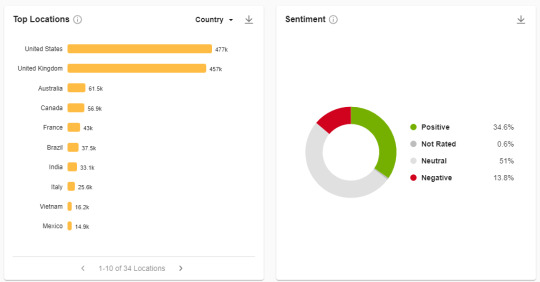
Where Mega's sentiment score is mostly negative (38%), you can see that only 13% of mentions on Catherine are negative, 51% are neutral and 34% are positive compared to Mega's 17% positive, so Catherine is viewed nearly twice as positively as Mega.
As you can see, location sources for Catherine's fans are almost equally US and UK. And like Mega, she has followers in Australia, Canada and France. And both have some fans in Italy, but what a surprise Catherine has a healthy chunk of fans in Brazil! And even Vietnam and Mexico!
Which now makes me think that the only reason Germany got on Mega's list was because of Invictus.
So I decided to see where else Catherine has fans by checking out the next pages of locations. (I will need to go back and do the same for Mega)
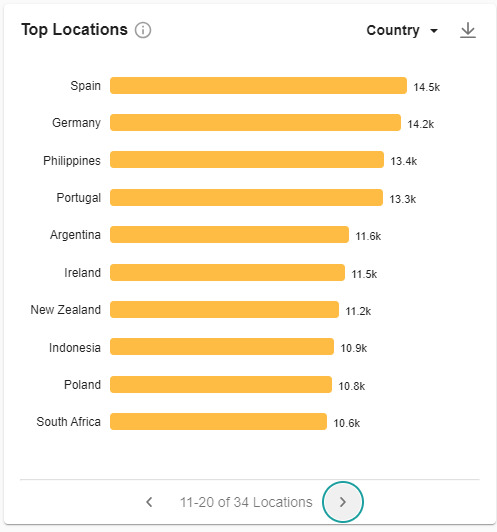

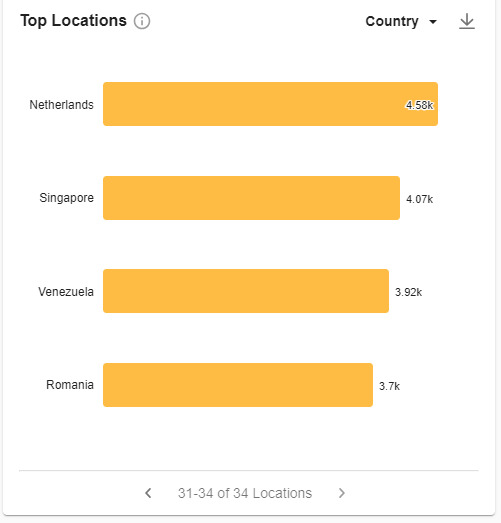
William is not trailing Mega by very far, with 3.14 million mentions in the same period.

Notice he is also up on the same period last year at a similar rate of increased mentions as Catherine between 3 and 4%. While Mega mentions are 21% down on the previous period. So I reckon people are getting bored.
William's locations and sentiment are a bit surprising.

More people in the US than the UK are mentioning William and the positive 25% versus the negative comments 24% are surprising. I need to did down and see if this is attacks by the SS.
So this is now filtered to give just the negative mentions of William.

More negative comments originate in the US. I notice though that a lot of the negative mentions refer to him being impatient regarding efforts to aid the planet. The AI language tool is picking those up as negative reports. So it is not foolproof.
So I think this will give everyone insight into why Mega's PR is full of flowery positive words and hyperbole and why it goes out in waves, her PR agency are desperately trying to change the negative sentiment by flooding the internet and online news sources with puff pieces.
There are some other features I would like to explore with this tool, but I need to go and pack for holiday!
127 notes
·
View notes
Text
In defense of ‘House of the Dragon’ costumes.
I doubt anyone will read this, but at least I can link to it instead of arguing with people.
I don’t even like the costumes that much, truly, but every fucking time the criticism is paired with examples of the costuming work on ‘The Borgias’, ‘The Tudors’, or even ‘Reign’. I have thoughts on the costumes from those shows too, but will readily admit they do have more detail and texture than most garments worn in HotD.
HOWEVER
Whenever I hear these mentioned in comparison I want to scream.
Tudors is set in 16th-century England.
Borgias is in 1490-1500 Italy
Reign [allegedly] depicts mid 16th century Europe.
None of these have examples of medieval fashion. The middle ages spanned from the 5th century to the 15th (and by then, the renaissance movement had come to Italy, so the Borgias does not depict medieval clothing, either.)
ASOIF is a fantasy universe, true, but GRRM has stated many times that the Middle Ages served as a basis for the world he created and that historical realism was an important grounding factor for making the universe feel real, too.
I think it’s fair to say this should apply to clothing, just as it applies to decor, atmosphere, and technological advancements in both the books and the show. Clearly it is supposed to replicate the middle ages, or a very similar equivalent in Westeros.
I’m happy to suspend some disbelief given the fact it is a fantasy setting—for example none of the garments in GoT were historically ‘accurate’ but the more traditional gowns kept a silhouette and stylistic details that were similar to garments from the 15th century [most pointedly Sansa’s and Cersei’s gowns from the earlier seasons] which would fit the period in history that influenced the books.

I genuinely think HotD was trying to do something similar, drawing from fashions from the slightly earlier 1300s/1400s—which follows with the established timeline.

And, obviously, that is very much not the time period shown in borgias, reign, or the tudors. It is in fact HUNDREDS of years earlier.
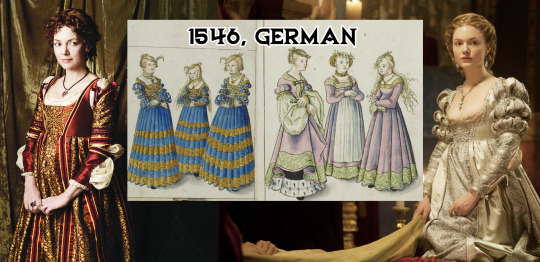
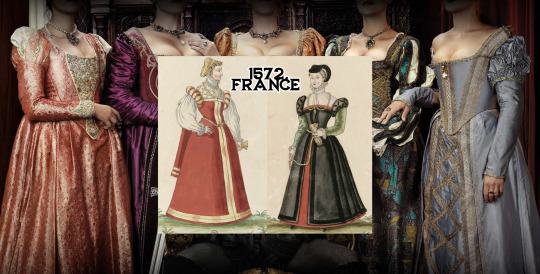
To put this into context:
Comparing the 1300s to the 1500s is equivalent to comparing your wardrobe to what is in a Jane Austen film.
Comparing the 1500s to the 1700s is like comparing civil war era uniforms to what is worn by the military today.
A lot changes in 200 years.
And you know what? Garments in the 1300s weren’t that pretty.
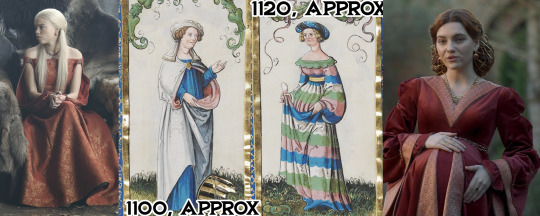
Almost all of them lacked closures, which meant they went over the head and were shaped with belts or ties.
Corsets were not worn during this period so any sort of tight, supportive, and shapely bodices in this era is a thing of fiction.
Though layers were often worn, they were typically only visible at the hems and not the neckline [so the layers of a partlet/visible chemise as seen in the 16th century was unlikely, too].
In fact the only realistic depiction of this period I've seen in costuming is on the show “Hollow Crown” and do you know what those dresses looked like? Well…
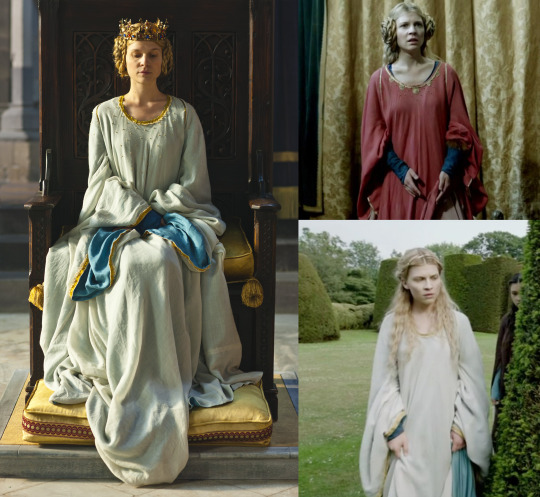
Not to mention this is a difficult period to research in general since so little paper survived. This website has timelines for fashion, and where the 15th century page features a dozen examples for each decade, the 14th century page has less than a dozen examples TOTAL.

Now I’m not saying the costumes couldn’t have been better. I do think fabrics with more texture could have made even the simple gowns look more interesting, and I wish the amazing embroidery that we saw hints of was better utilized.

But, I think given the historical examples the designer was probably tasked with interpreting in a fantasy setting, the costumes are just not going to be as fantastic as what you see in dramas from later periods.
(The wigs however were unforgivable, i’ll give you that, lol. )
ALSO I'm not saying you can't complain about them or think they were ugly. I'm just saying that if you are going to compare them to something, please compare them to garments from other fantasy dramas, or things that actually take place in the same period.
Ok. Rant over.
#game of thrones#house of the dragon#costume design#costume#targaryen#hbo#historical#medieval fashion#middle ages#medieval dress#rant
36 notes
·
View notes
Note
hopping into ur inbox to ask if are there any resources you might be able to share from the class w the renaissance anatomical art 👀 my undergrad thesis is tentatively on early modern bodies (along the lines of poetic blazons but also—relics and dissections, etc) and i’m scooping stuff up in a hurry
Oh I know a few things you might be interested in! Some from that class and some from my own bookmarks (one of my own degree concentrations is in the history of science, and I have a business of hoarding interesting-sounding articles)
Anything good on Andreas Vesalius tends to get into interesting discussions about how the body was viewed in the Renaissance, in the class I'm currently taking we read both Pamela O. Long's "Objects of Art/Objects of Nature: Visual Representation and the Investigation of Nature" and a selection from Sachiko Kusukawa's Picturing the Book of Nature, Image, Text, & Argument in Sixteenth-Century Human Anatomy and Medical Botany
If you're not already familiar with Katharine Park, I am a fan and she's done a few things on the subject of the body in about the right era, including "The Life of the Corpse: Division and Dissection in Late Medieval Europe" and "The Criminal and the Saintly Body: Autopsy and Dissection in Renaissance Italy" (which was actually featured in the Pentiment bibliography, haha), as well as the book Secrets of Women: Gender, Generation, and the Origins of Human Dissection
We also read a selection in my current class from Simon Schama's Rembrandt's Eyes, as the chapter "Amsterdam Anatomized" gets in the painting of "The Anatomy Lesson of Doctor Tulp" although after that the sources from that course may start getting a little too late for your interest (more Enlightenment than Renaissance)
I hope some of that gets you moving in the right direction!
23 notes
·
View notes
Text
Ladies please share to spread the word about two exhibits featuring women artists in two different cities

Artemisia Gentileschi, Self Portrait as Saint Catherine of Alexandria (ca. 1615–17). Collection of the National Gallery, London.
Renaissance art calls to mind some of the greatest names in art history—Da Vinci, Raphael, Michelangelo, and Donatello, just to name a few. Lesser known, however, are the influential women artists who shaped the era.
Referring to a period that bridged the end of the Middle Ages and early Modernism, the Renaissance was marked by a widespread effort to recover and advance the accomplishments of classical antiquity. Originating in Florence, Italy, but soon spreading throughout Europe, Renaissance art saw the advent of advanced linear perspective and an increase in realism. Many women artists—famous in their own time—were among these great visionaries.
Though for centuries, these women artists were largely overlooked in the annals of art history, contemporary scholarship has begun a long overdue reappraisal and rediscovery of their lives and works. Evidence of this resurgence of interest in the women artists of the Renaissance can be seen in the two current major museum shows in the U.S. that are dedicated to just that. “Strong Women in Renaissance Italy” at the Museum of Fine Arts, Boston brings together over 100 works from the 14th through early 17th century, exploring the lives and work of Italian women artists and is on view through January 7, 2024. At the Baltimore Museum of Art, “Making Her Mark: A History of Women Artists in Europe, 1400–1800” is a sweeping exhibition that aims to rectify critical oversight and bring awareness to historical women artists, and is also on view through January 7, 2024,.
In light of these two important exhibitions, we’ve brought together a brief introduction to five Renaissance women artists whom we think you should know.
Plautilla Nelli (1524–1588)

Plautilla Nelli, St. Catherine with Lily (ca. 1550). Collection of Le Gallerie Degli Uffizi, Florence.
Plautilla Nelli was a nun of the Dominican order at the convent of St. Catherine of Siena in Florence—and is considered by many scholars to be the first-known woman artist of Renaissance Italy. A self-taught painter, Nelli led a women’s artist workshop from the convent, and she was one of the few women mentioned in Vasari’s seminal treatise Lives of the Most Excellent Painters, Sculptors, and Architects. Because she developed her practice without formal training and was forbidden from studying male nudes, Nelli frequently copied works by other artists, as well as motifs from religious texts and sculpture.

Nelli’s work recently came into the limelight for her immense painting Last Supper, dating to 1568. Measuring over 21 feet long and 6 feet high, the painting remained in her convent’s refectory until the early 19th century, before being moved to another convent’s refectory and, ultimately, being placed in storage. Following an early 20th-century restoration and several more moves, it went on view to the public for the first time in over four centuries at the Santa Maria Novella Museum in 2019. Hanging alongside other masterworks by artists like Brunelleschi, it finally is getting the widespread recognition it deserves.
Catharina van Hemessen (1528–after 1565)
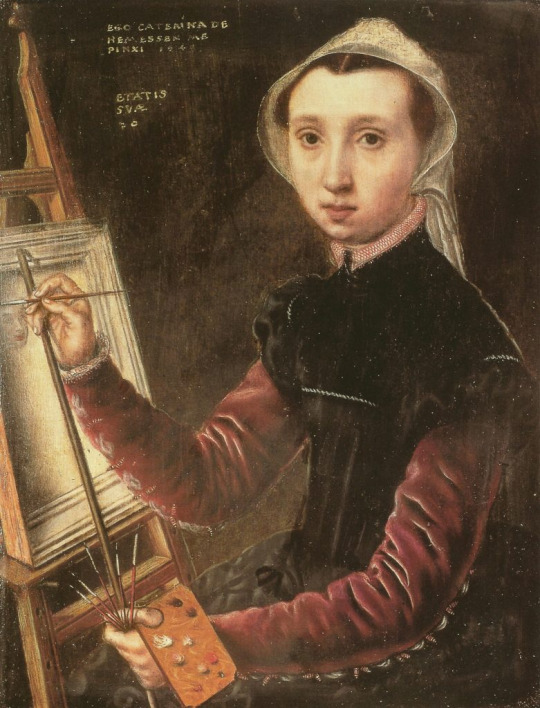
Catharina van Hemessen, Self-Portrait (1548). Collection of Kunstmuseum Basel.
Northern Renaissance painter Catharina van Hemessen was the daughter of prominent Mannerist painter Jan Sanders van Hemessen, and is the earliest Flemish woman painter with verified work that still exists today. Hailing from Antwerp, van Hemessen achieved success in her lifetime, including obtaining the patronage of Maria of Austria, regent of the Low Countries. She was included both in Vasari’s collection of artist biographies, as well as artist biographer Lodovico Guicciardini’s Description of the Low Countries (1567). Van Hemessen’s greatest claim to fame, however, is that she is attributed with completing the first known self-portrait of an artist at their easel—a compositional approach that has become a pillar of the art historical canon, as it has been taken up by artists ranging from Rembrandt van Rijn to Norman Rockwell.
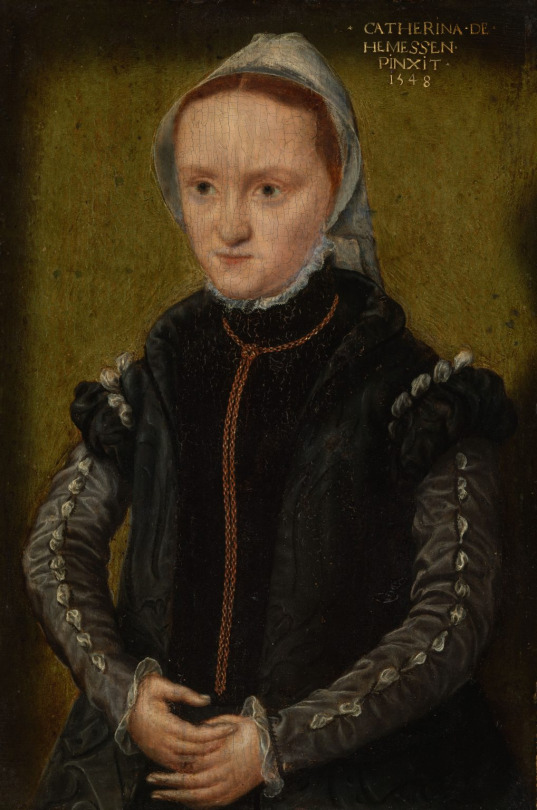
Though she created religious images, she was most well known as a portraitist. Eight portraits and two religious compositions signed by van Hemessen have survived, dating between 1548 and 1552. Notably, there are no verifiable works dating to later than 1554, which have led scholars to believe she ceased painting following her marriage to organist Christian de Morien that year—though there are records she continued to teach three male apprentices.
Sofonisba Anguissola (ca. 1532–1625)
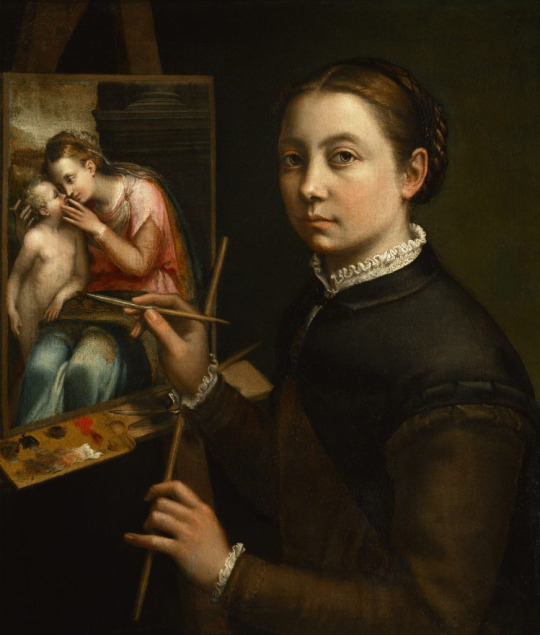
Sofonisba Anguissola, Self-portrait (ca. 1535–1625). Collection of Łańcut Castle Museum, Poland.
Sofonisba Anguissola was one of the most successful women artists of the Renaissance, with a reputation that rose to international acclaim in her lifetime. Born into a noble Milanese family, Anguissola was able to pursue her artistic aspirations with the support of her family, and began her formal training as a teenager; first apprenticing with Bernardino Campi for three years before working with Bernardino Gatti. Her position also allowed for her to become acquainted with Michelangelo, whom she exchanged drawings with. Her early career saw her complete numerous self-portraits as well as portraits of her sisters, including The Game of Chess (1555), which are noted for their realism and liveliness.

Sofonisba Anguissola, The Game of Chess (ca. 1555). Collection of the National Museum in Poznań, Poland.
Anguissola’s reputation as a painter quickly spread, and she was invited to join the court of King Philip II of Spain in Madrid in approximately 1559. Throughout her 14-year tenure there, she completed many official portraits of both members of the royal family and members of the court, adopting the formal and intricate style expected—though unfortunately, no work from this period survived due to a palace fire in the 18th century. Having garnered considerable royal favor, she ultimately spent the remainder of her life continuing to paint as well as teach and engage with young, up-and-coming artists. In 1624, one such young artist by the name of Anthony van Dyck visited Anguissola and recorded his visit in a series of sketches and noted that he learned more about the principles of painting from her than from anything else he had encountered.
Lavinia Fontana (1552–1614)

Lavinia Fontana, Self-portrait at the Spinet with Maid (1577). Collection of the Accademia Nazionale di San Luca, Rome.
Trained by her artist father Prospero Fontana, a teacher at the School of Bologna, Lavinia Fontana is considered the first professional woman artist insofar as she supported herself and her family solely on the income from her commissions. Unconventional for the time, her husband acted as her agent and took a primary role in childcare for their 11 children. She began her commercial practice in her mid-twenties, creating small devotional paintings, but later began and excelled at creating portraits—and became a favorite of Bolognese noblewomen who vied for her services. Unusual for the period, she also created large-scale mythological or religious paintings that occasionally featured female nudes.

Lavinia Fontana, The Visit of the Queen of Sheba to King Solomon (1599). Collection of the National Gallery of Ireland, Dublin.
In the early years of the 17th century, she was invited to Rome at the invitation of Pope Clement VIII and was soon appointed as an official portraitist at the Vatican, counting Pope Paul V as one of her sitters. Her career success continued to thrive, as evidenced by the numerous honors she received, and the bronze portrait medallion cast in her likeness by sculptor and architect Felice Antonio Casoni. She was also one of the first women elected to the Accademia di San Luca in Rome.
Artemisia Gentileschi (1593–1653)
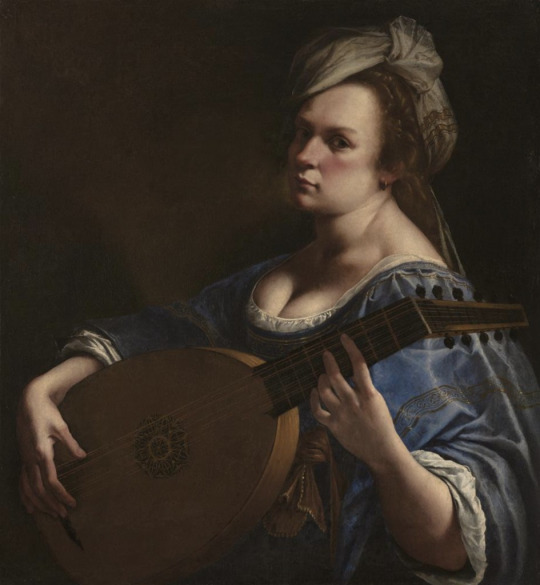
Artemisia Gentileschi, Self-portrait as a Lute Player (ca. 1615–1618). Collection of the Wadsworth Atheneum Museum of Art, Hartford.
Unlike many of her predecessors, Artemisia Gentileschi has maintained a level of renown over the centuries, with her dramatic and dynamic oeuvre that was unprecedented in her own time. Her Baroque compositions helped usher in a new era of painting. Today, her paintings draw the attention of global audiences. Born in Rome, her father was the painter Orazio Gentileschi, who trained Artemisia starting at an early age. Inspired greatly by the work of Caravaggio and his use of high-contrast compositions, her paintings garnered and maintained attention for their naturalism and nuance, as they broke from the idealism of generations past.

Artemisia Gentileschi, Judith and Her Maidservant with the Head of Holofernes (ca. 1623–1625). Collection of the Detroit Institute of Arts.
In 1612, Gentileschi relocated to Florence, which is where she first achieved major career success, including securing patronage from the House of Medici and being the first woman to attend the Accademia delle Arti del Disegno. From her oeuvre, Gentileschi has become most well-known for her self-portraits as well as religious scenes, specifically the story of Judith Beheading Holofernes—of which there are at least six known variations she completed. Gentileschi’s tendency to portray women as the protagonists of her works—and as equals to their male counterparts—made her innovative in her time and has subsequently secured her legacy as one of the most influential artists within Western art history—of either sex.
#Women in Art#Strong Women in Renaissance Italy#Museum of Fine Arts#Boston#There until January 7 2024#Making Her Mark: A History of Women Artists in Europe 1400 -1800#Baltimore Museum of Art#Plautilla Nelli (1524–1588)#Catharina van Hemessen (1528–after 1565)#Catharina van Hemessen created a whole genre in self portraits#Sofonisba Anguissola (ca. 1532–1625)#Lavinia Fontana (1552–1614)#Artemisia Gentileschi (1593–1653)
10 notes
·
View notes
Text
A Plutarchian Woodcut Wednesday
We’re spending our Woodcut Wednesday with this stunning sixteenth-century edition of Plutarch’s classic Parallel Lives featuring the work of artists Jost Amman and Tobias Stimmer.

The allegory of Fama, otherwise known as Fame or Renown, by Tobias Stimmer opens Plutarch’s Parallel Lives on the title page.

Various scenes from the life of the legendary Athenian monarch Theseus, including the hunt of the Calydonian boar and the hero throwing Sciron off a cliff edge. Plutarch pairs the Greek Theseus with the Roman Romulus.

The founding of the city of Rome under Romulus. The murder depicted in the foreground could be Romulus slaying Remus in the dispute over where Rome ought to be built.
Plutarch (ca. 46-after 120 A.D.) was born under Roman rule in Chaeronea, Boeotia, to a wealthy and established Greek family. Plutarch traveled to Athens in the mid-60s to study a variety of subjects, including medicine, physics, Latin, and philosophy. Though they were technically the conquering rulers, Romans at the time valued their Greek subjects’ culture of learning, and Plutarch was among those invited to tour Italy as a lecturer. Plutarch’s moral and philosophical lessons enjoyed success and formed the basis of his later written works. Parallel Lives was penned towards the end of Plutarch’s life when he had returned to Greece and was serving as a statesman and head priest of Apollo.

The unfortunate demise of the scholar Archimedes at the hands of Marcellus’ forces as they sack Syracuse. Plutarch relates that Marcellus’ greatest regret was the death of the famous mathematician.
Parallel Lives (Gk., Bioi paralleloi) is a moralistic set of biographies that examines the lives of notable Greek men and their Roman counterparts. The biographies are moralistic in the sense that Plutarch did not intend to write historically accurate accounts but rather wanted to draw out the lessons to be learned from the examples, both good and bad, of the lives of famous Greek and Roman individuals. Parallel Lives had a profound influence on readers from Plutarch’s contemporaries in the Roman Empire up through to the Middle Ages and early Renaissance. For example, William Shakespeare drew heavily on Plutarch’s Parallel Lives to write the plays Coriolanus, Timon of Athens, Antony and Cleopatra, and Julius Caesar.

Coriolanus and his forces, in the Volscian camp, hear the pleas of his mother, wife, and the women of Rome to stop his attack on the city. Coriolanus relents and the women are later honored with the building of a temple to the goddess Fortuna.
The edition of Parallel Lives featured in this post was printed by Frankfurt am Main publisher Sigmund Feyerabend (1528-1590) in 1580. The text is the Latin translation of Heidelberg University scholar Wilhelm Xylander (1532-1576), who famously produced the first Latin translation of Marcus Aurelius’ Meditations. The woodcut illustrations are the work of the prolific Swiss-German artist Jost Amman (1539-1591) and Swiss painter Tobias Stimmer (1539-1584). As an interesting sidenote, several of the woodcuts appearing in this edition of Plutarch were recycled from Feyerabend’s 1568 edition of Livy’s History of Rome.
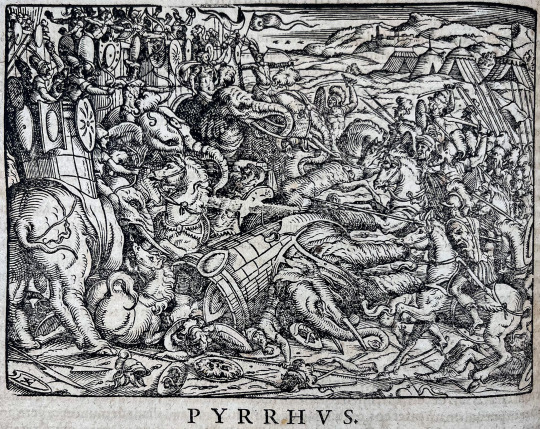
Battle between two armies, one on horseback and the other on war elephants. This generic illustration is repeated for Plutarch’s Life of Alexander (the Great) and Life of Pyrrhus (of Epirus). The former famously fought against forces that used elephants; the latter notably used them in battle.

As a change of pace from all the foregoing imagery of bloodshed and gore, we'd like to end with this elaborate woodcut of Aristotle seated at a table of scholars. Aristotle is not among the lives covered in the Bioi paralleloi, but this edition adds a brief biography of the philosopher by Guarino Veronese.
Images from: Plutarch. Vitae illustrium vivorum Graecorum et Romanorum. Frankfurt am Main: Sigmund Feyerabend, 1580. Catalog record: https://bit.ly/3DUnWhl
61 notes
·
View notes
Text
Santa Chiara
Continuing my series of learning about things referenced in the book, I'm looking at things referenced in Alex & Henry's visit to the V&A Museum. These are all tagged #a series of learning about things that are referenced in the book, if you want to block the tag.

Through the marble choir screen at the back of the room is a second, deeper chamber, this one filled with church relics. Past stained glass and statues of saints, at the very end of the room, is an entire high altar chapel removed from its church. The sign explains its original setting was the apse of the convent church of Santa Chiara in Florence in the fifteenth century, and it’s stunning, set deep into an alcove to create a real chapel, with statues of Santa Chiara and Saint Francis of Assisi. When they kiss, Alex can hear a half-remembered old proverb from catechism, mixed up between translations of the book: “Come, hijo mío, de la miel, porque es buena, and the honeycomb, sweet to thy taste.” He wonders what Santa Chiara would think of them, a lost David and Jonathan, turning slowly on the spot.
-Chapter 10, Red White & Royal Blue
-----
The visual provided for this scene is the Chancel Chapel from the Church of Santa Chiara, in Florence. The only Italian Renaissance chapel outside of Italy, it consists of four parts - the Chapel and Frieze, the Tabernacle, and as Alex references, the Statues of Saint Francis and Saint Claire/Chiara. While the artist is unknown, it has been attributed to Giuliano de Sangallo or those associated with him, in the last decade of the 1400s. It was purchased on behalf of the V&A museum in 1860 by J.C. Robinson.
The Chapel belonged to the Poor Clares order of nuns, whose founders were the Saints featured in the piece - St Francis and St Claire/Chiara. The convent of Santa Chiara was founded on the site of a hospital, and this altar was commissioned by the brother of some of the nuns, Jacopo Bongianni in the 1490s.
-----
The proverb Alex remembers is from Proverbs 24:13. I've included both the English and the Spanish versions. I used the King James Version of the English bible and the Reina-Valera Antigua for the Spanish version.
Come, hijo mío, de la miel, porque es buena, Y del panal dulce á tu paladar.
My son, eat thou honey, because it is good; and the honeycomb, which is sweet to thy taste.
-----
David and Jonathan are characters in the Book of Samuel in the bible. Many queer people look to them as an example of a queer relationship that was affirmed and blessed by God. Jonathan was the son of the first King of Israel, and David became the second King of Israel.
When they were introduced to each other, Jonathan took an immediate liking to David and "the soul of Jonathan was knit to the soul of David and Jonathan loved him as himself". [1 Samuel 18] Following Jonathan's death, David expresses that Jonathan's love for him was "more wonderful than that of women". [2 Samuel 1] He also later adopts Jonathan's adult son, Mephibosheth, saying "I will [...] show you kindness for the sake of your father Jonathan." [2 Samuel 9] He does so despite the risk this poses to his position as King - Mephibosheth was a potential claimant to the throne, being the grandson of the former King.
Oscar Wilde referenced David and Jonathan in the well known reference to "the love that dare not speak its name" during his trial. We know that Henry has an affection for Wilde - Alex sees a copy of his complete works on Henry's nightstand.
Sources:
V&A - Chancel chapel from Church of Santa Chiara, Florence
Proverbs 24:13, Spanish and English
QSpirit - David and Jonathan: Same-sex love between men in the Bible - the comments on this contain homophobia
Samuel references - 1 Samuel 18, 2 Samuel 1, 2 Samuel 9
#rwrb#red white and royal blue#rwrb movie#elio's#elio's meta#long post#a series of learning about things that are referenced in the book#two today because i dont think anyones going to be interested tomorrow lol#this is the end of the series for now#ive got more i want to add#but i need a break
12 notes
·
View notes
Text
Christ Crucified d.1632 by Diego Velázquez.
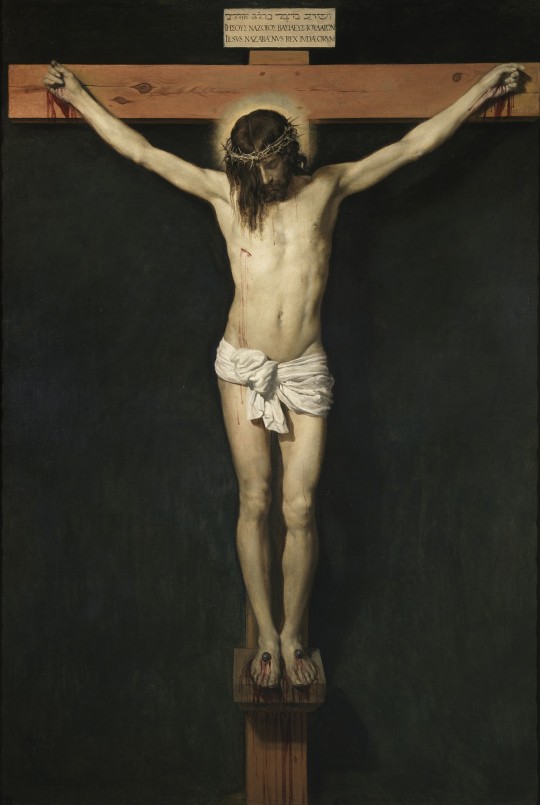
📍Museo del Prado, Madrid.
Diego Velázquez was a Spanish painter in the Baroque period. He studied under Pacheco at age 12 and was accepted into the Painter's Guild of St. Luke at age 18. He married Pacheco's daughter and his reputation grew in Seville. In 1622, he was summoned to the court of Philip IV to accept the vacant court painter position. He went to Italy for a period in 1629, studying the Renaissance masters. He returned to Madrid and continued his work at Court. He returned once more to Italy where he painted Pope Innocent X. He was the most important Spanish painter in the 17th century and his artwork became a model for 19th century Realist and Impressionist painters.
Baroque is a style of painting and other arts that flourished in Europe from the beginning of the 17th century to around the mid-18th century. In the territories of the Spanish and Portuguese empires it would last until the beginning of the 1800s, however. The Baroque style featured use of contrast, movement, exuberant detail, deep colours, grandeur in order to achieve a sense of awe. It was encouraged by the Catholic Church during the Counter-Reformation, in opposition of the simplicity and austerity of Protestant art.
The painting follows the accepted iconography of the 17th century: four nails, feet together and supported against a little wooden brace in a classic 'contrapposto' position. The painting is understated, with a dark background. The cross is plain and lacks any adornment. Christ himself is similarly unadorned. Both arms are slightly curved, instead of forming a triangle. The loincloth is small, showing the nude body as much as possible. His face rests on his chest, showing just enough of his face. Much is covered by his hair, perhaps foreshadowing death. A small hint of divinity lies in his modest halo. It lacks the typical characteristics of a Baroque painting.
#christ crucified#diego velazquez#crucifixion#jesus christ#baroque#art#art history#painting#museo del prado#my favourite paintings
13 notes
·
View notes
Text
✍️ - Blog #4
Despite both Rome and Florence being in the same country, both areas have distinct differences. Rome, situated in the region of Lazio, and Florence, situated in the region of Tuscany, are both cities with rich history and cultural disparities. I noticed that while both cities have similarities, they also exhibit differences.
Rome, as the capital city of Italy, has a rich history dating back to ancient times, featuring iconic landmarks such as the Colosseum, the Roman Forum, and the Pantheon. The city is also home to Vatican City, an independent city-state that serves as the headquarters of the Roman Catholic Church. Vatican City is home to iconic landmarks like St. Peter's Basilica and the Sistine Chapel.
In contrast, Florence has a strong history, particularly during the Renaissance. Often considered the birthplace of the Renaissance, Florence has a more concentrated focus on art and culture compared to Rome's broader emphasis on history.
As for cuisine both cities emphasize Italian, given their location. However, Rome is known for its hearty and diverse Italian cuisine, including pasta dishes like carbonara and cacio e pepe. Florence, on the other hand, is renowned for its Tuscan wine and cuisine, featuring popular dishes such as ribollita and bistecca alla fiorentina.
Both Rome and Florence, despite being apart of the same country, offer different experiences that are shaped by their history, architectural styles, and culinary traditions.

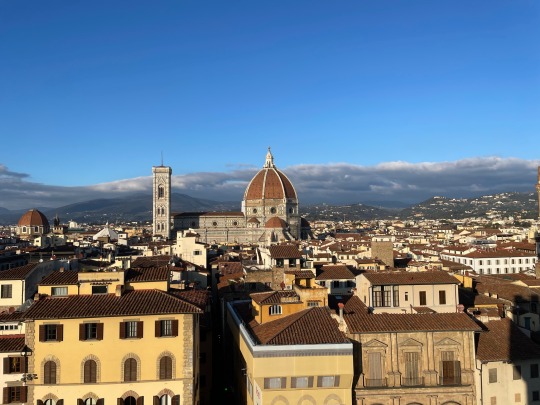
6 notes
·
View notes
Text
The Timeless Elegance of 17th Century Tuscan Armchairs: A Glimpse into Renaissance Opulence
The 17th century Tuscan armchair stands as a testament to the rich history of Italian furniture craftsmanship and design. Born in the heart of Tuscany during a period marked by cultural and artistic flourishing, these chairs embody the elegance and sophistication of the Renaissance era.
Crafted with meticulous attention to detail, the Tuscan armchair of the 17th century reflects the prevailing artistic and architectural styles of the time. Influenced by the Renaissance, which had its origins in Italy during the 14th century, the 17th century saw a continuation and refinement of these artistic principles. Tuscan furniture makers drew inspiration from classical Roman and Greek designs, incorporating elements such as ornate carvings, graceful curves, and a harmonious balance of form and function.
One of the distinctive features of the 17th century Tuscan armchair is its solid and sturdy construction. Crafted from robust hardwoods such as oak or walnut, these chairs were built to endure the test of time. The frame often featured intricately carved details, showcasing the skill of the artisans who meticulously shaped the wood into elaborate patterns and motifs. The legs were typically thick and robust, providing stability and support.
The backrest of the Tuscan armchair was a canvas for artistic expression, adorned with intricate carvings that ranged from floral motifs to mythological scenes. These carvings not only added aesthetic appeal but also conveyed the cultural and intellectual currents of the time. The arms of the chair, as the name suggests, were designed to provide comfort and support, often featuring scrolls or gentle curves that added to the overall grace of the piece.
The upholstery of the 17th century Tuscan armchair was another element that showcased the luxurious tastes of the period. Rich fabrics such as velvet and damask were commonly used, and the upholstery was often embellished with elaborate embroidery or tufting. The choice of fabric and embellishments reflected the social status of the owner, with more opulent materials reserved for the nobility and aristocracy.
Functionality was not sacrificed for the sake of aesthetics in the design of the Tuscan armchair. While the chair exuded an air of grandeur and sophistication, it was also created with comfort in mind. The seat was often generously padded, providing a luxurious and inviting place to rest. The ergonomic design of the chair allowed for prolonged use without sacrificing comfort, making it a functional piece of furniture for both formal and informal settings.
The 17th century Tuscan armchair was not merely a piece of furniture; it was a symbol of status and cultural refinement. In a society where appearances and symbols of wealth held great significance, owning a well-crafted Tuscan armchair was a statement of one's taste and social standing. These chairs were often found in the homes of the elite, gracing the halls of palaces and the drawing rooms of the upper class.
Today, the legacy of the 17th century Tuscan armchair lives on in the world of interior design and antique collecting. While original pieces from this period are rare and highly sought after by collectors, modern reproductions pay homage to the timeless elegance and craftsmanship of the original design. The enduring appeal of the Tuscan armchair lies in its ability to seamlessly blend the opulence of the past with the demands of contemporary living spaces.
The 17th century Tuscan armchair stands as a masterpiece of Italian furniture design, capturing the essence of the Renaissance era. Its solid construction, intricate carvings, and luxurious upholstery reflect the craftsmanship and artistic sensibilities of the time. As a symbol of status and cultural refinement, the Tuscan armchair has left an indelible mark on the history of furniture design and continues to inspire and captivate admirers to this day.
2 notes
·
View notes
Text
Gaze upon the attractions of Palazzo Vecchio

Pallazo Vecchio located in Florence, Italy
Let's delve into the brief history of Palazzo Vecchio
The history of Palazzo Vecchio dates back to 1299 when the citizens of Florence decided to erect a grand palace to house their government institutions. It was to stand as a symbol of the republic's power and the people's authority. The renowned architect Arnolfo di Cambio, known for his work on the Florence Cathedral and the Santa Croce Church, undertook this ambitious project on the remnants of the Palazzo dei Fanti and the Palazzo dell'Esecutore di Giustizia in Piazza della Signoria. As was customary for major constructions of that era, multiple generations were involved in its completion, leading to various modifications and expansions.
In the 16th century, Cosimo I de Medici orchestrated a significant renovation and embellishment of the building, transforming it into his residence, thus bestowing upon it the name "Ducal Palace." Subsequently, Cosimo I moved his residence to the Pitti Palace, and the Palazzo Ducale became known as Palazzo Vecchio, serving as the hub of government offices and a repository for valuable items.
Cosimo I also commissioned the construction of a connecting corridor, the Vasari Corridor, which linked the Pitti Palace with the administrative offices, now known as the Uffizi Gallery, and Palazzo Vecchio. This corridor provided a more convenient and private means of moving between these locations.

The Current Status of Palazzo Vecchio
Throughout its extensive history, the palace has gone by various names. Its original name was Palazzo della Signoria, which was later changed to Palazzo Vecchio when the Medici court relocated to the Pitti Palace. Currently, Palazzo Vecchio serves as the home of the Museo dei Ragazzi, and it houses the administrative offices of the Town Hall. Additionally, the Cinquecento Hall, which still retains its original function, hosts special audiences and events.
Fascinating Tidbits about Palazzo Vecchio
Were you aware that Palazzo Vecchio is situated in Piazza della Signoria, the most prominent square in Florence? This stunning square is nestled between Piazza del Duomo and the Arno River, and Palazzo Vecchio stands as its most iconic edifice. Adorning its entrance are remarkable sculptures, including depictions of Adam and Eve, a copy of Michelangelo's David, and Hercules and Cacus. The square also features the Loggia dei Lanzi, the Fountain of Neptune, and the equestrian statue of Cosimo I.
Did you know that within Palazzo Vecchio, a network of concealed passages exists? These secret passages, commissioned by the Medici, served as escape routes from potential threats and as repositories for precious items. For instance, concealed behind the map of Armenia in the Stanza delle Mappe (The Map Room) is a hidden entrance leading to the dressing room of Duchess Bianca Capello, the second wife of Francesco I.

Why a Visit to Palazzo Vecchio is an Absolute Must
A journey to Florence, the birthplace of the Italian Renaissance, would be incomplete without a visit to the iconic Palazzo Vecchio. This historical gem, also known as the Old Palace, stands as one of the most renowned symbols of the city. Constructed in the likeness of a formidable castle, with a towering 94-meter-high tower, it was built between 1299 and 1314. Palazzo Vecchio was intended to serve as both the residence and workplace of republic officials, offering a captivating array of rooms, each with its own distinctive character.
Your exploration of Palazzo Vecchio commences in the grand "Salone dei Cinquecento" (Hall of the Five Hundreds), an expansive chamber that spans an impressive 54 meters in length, 22 meters in width, and soars to a height of 17 meters, rendering it the largest room in all of Florence. This awe-inspiring historical landmark promises an unforgettable journey through the heart of the Italian Renaissance. So, why wait? Embark on an adventure through history at Palazzo Vecchio today!
How to Explore Palazzo Vecchio (Old Palace)
Visiting Palazzo Vecchio, a symbol of Florence's civil power for over seven centuries, offers an enriching historical experience, best accompanied by an expert guide's insights.
To embark on this journey, you can secure entry to the building by purchasing a Palazzo Vecchio admission ticket combined with the Audio Guide of Florence, which comes with priority entrance privileges.
A variety of tour options are available, catering to diverse interests. These range from the traditional Palazzo Vecchio tour to the guided exploration of Dan Brown's Inferno, delving into the palace's more enigmatic aspects. Of course, opting for a private guide is also highly recommended. These itineraries are versatile and can be tailored to your preferences. For example, the private tour based on Dan Brown's Inferno and the Boboli Gardens will immerse you in the very locations vividly described in the famous book, creating a truly personalized and memorable experience.
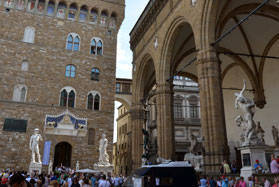
Travel Route from the Philippines to Palazzo Vecchio in Florence, Italy:
1. **Philippines to Rome, Italy by Air:**
- Start your journey by booking a flight from the Philippines to Rome, Italy. The main international airport in Rome is Leonardo da Vinci-Fiumicino Airport (FCO).
2. **Transfer to Florence:**
- After arriving in Rome, you can choose to take a connecting flight to Florence. Florence's main airport is Amerigo Vespucci Airport (FLR). Alternatively, you can take a train or bus from Rome to Florence if you prefer overland travel.
3. **Arriving in Florence:**
- Once in Florence, you'll find yourself in the heart of the city. Palazzo Vecchio is located in the historic center, specifically in Piazza della Signoria. You can reach it by walking, as Florence is a very pedestrian-friendly city.
4. **Exploring Palazzo Vecchio:**
- Upon reaching Piazza della Signoria, you'll see the impressive Palazzo Vecchio. Purchase your admission ticket at the entrance and begin your exploration of this historic landmark.
Remember to check the latest travel regulations, flight availability, and visa requirements before planning your trip, as they may change.
Enjoy your journey to Palazzo Vecchio!
Reference:
Florence Museum. (n.d.). Palazzo Vecchio. https://www.florence-museum.com/palazzo-vecchio.php
4 notes
·
View notes
Note
I'll confess I don't know the base of the AU but I badly want to know about that Saya no Uta AU. I have never seen anyone say they had a Saya no Uta AU for anything.
Oh, this one will be fun!
CW: heavy blood/gore. I'm not joking. Do not read if this kind of stuff disturbs you. Also cannibalism mention and body horror.
To catch you up on the base universe (Pillars of Eternity), it is a fantasy RPG with a unique world and races. The biggest component of this game world is that souls exist, and that when a person dies, their soul travels through a Wheel to be distributed to the next person. Soul essence is also very powerful and can be used to power various wonders and technologies. The player character is a Watcher, someone who can see and manipulate souls.
The second game takes place on an archipelago where various factions compete for resources and dominance while a god tracks his way through the islands to get to a lost city. It falls very heavily into dark fantasy (especially the first game), but in a cool way and not a GoT-wannabe kind of way. It has many settings that are (awesome) super dark and gruesome. I love it so much.
My OC Amali is a death godlike. Her base race is human (though any race can be a godlike), but when she was in-utero, the god of death imparted some of their essence into her, giving her horrifying features and a few abilities related to death and dying. Amali is a poor artist from Old Vailia (a culture resembling Renaissance Italy but in decline). She's also a cipher, which gives mind reading and mind manipulation powers. Her love interest is Tekēhu, an NPC who is a native of the Deadfire Archipelago. Tekēhu is also a godlike, but unlike Amali, Tekēhu's culture hold the godlike in high regard. Tekēhu especially received special treatment and privileges because he is a marine godlike, a super rare type of godlike not available to player characters that holds special importance to his culture, unlike Amali, whose culture view the godlike with suspicion and disdain, especially death godlike.
Amali is what TvTropes would call a Nightmare Fetishist. As both a person and an artist, she is absolutely drawn to the dark and macabre. Her drawings are all drawn in painstakingly, almost disgustingly meticulous detail, meant to "pull back the curtain" and showing the ugly and often overlooked side of the world. Despite this, she is a very pleasant and passionate individual, having more of an anti-nihilistic view than a depressing one.
Okay, now on with the AU!
Because of Amali's fascination with the dark and frightening, I always thought it would be fun to see how she would react if she were struck with the same affliction Fuminori had, to see the world as some sort of gore and fleshy hellscape, to see everyone around her, including her loved ones, as awful oozing monsters that were barely recognizable as the people she knew before.
I'm not exactly sure how Amali comes to be "infected", but I imagined a huge dramatic change right in the docks of Neketaka. Idk, Amali and her party are there, and Amali detects horrific disgust for absolutely everything coming from a young man from Rauatai (the setting's version of Imperial Japan). The sheer hatred this young man is broadcasting is completely overwhelming and Amali goes to find him. She makes the mistake of trying to telepathically reach out to him, and is overwhelmed by the horrific images in his mind. She passes out right there on the docks.
Amali wakes up to a nightmare. The wood and stones of the docks and streets and boats and houses are awful edifices of bone and sinew bobbing up and down an ocean of sludge while fleshy bits stick out of everything. The sky is a mesh of rotting rust with an oozing and pulsating sun overhead. The once salty air reeks of bile and rot, but is also...faintly sweet? (The fish guts now smell of floral perfume). And Amali is surrounded by monsters, creatures of exposed flesh and pulsating ooze with horrible alien appendages, gurgling monstrosities of every size and form, each unique in how disgusting they all are. When Amali comes to on the dock, she does not recognize where she is, nor does she recognize her party members (including her lover Tekēhu and her best friend Aloth), who have gathered around her. At first Amali freaks out, even pointing her gun at Tekēhu when he tries to come close. She runs from her party members, and they give chase, pursuing her right through the docks of Neketaka. Amali manages to lose them, having to navigate this fleshy and alien nightmare, until she reaches a high point over the docks, where she realizes...the very shape of those pulsing towers of flesh, the shoreline where bone and sinew meet sludgy water, the structure of the streets...holy shit, one of those bone ships docked in her spot looks suspiciously like the vessel she herself captains...Amali realizes with dawning horror that this aberrant hellscape...is Neketaka.
I didn't spend too much time on a "plot". It was basically an excuse to have Amali react to this new situation and imagine little scenarios of her and her friends dealing with it. Amali eventually returns to her ship and meets back with all her friends. She is truthful to her party members about what is going on with her and explains that she seems to be suffering from some sort of agnosia that is making the world around her seem like a living hell. However, she asks them not to disclose her condition without her permission. They all agree and are generally very supportive of her.
Amali has a lot of fun coming up with ways to deal with her new condition. It's still frightening and disturbing to her, and she would still rather go back to normal, but she enjoys the certain aspects of it that she can. Using her talents as an artist, she is able to find decorations and color schemes that are more pleasing to her. She also uses her sketchbook to draw everything she sees in this new perspective, including her friends. The people around her are super disturbed, but her friends are still supportive as they try to help her through this. She also learns that, once she finishes a painting or a drawing of something she sees, when she turns away from it and comes back, it looks just like its normal subject matter, which helps tremendously.
Food is also a lot of fun. Amali never resorts to cannibalism like Fuminori does, but at some point she figures out that the fish guts and other refuse from meat stores look and smell like lovely herbs and berries. Like with colors, she goes around collecting disgusting foods that are safe to eat. Most of her crew and party members are appalled, but some of the ones more inclined to macabre and dark humor (like Maia and Xoti) make a game of going out and finding what awful disgusting glop they can feed Amali. When she recovers, they make a point of never mentioning some of the things she ate while in her condition.
The hardest and most sad part of all this is Tekēhu. Whereas he was a very handsome man and the most beautiful person Amali has ever met, now he is the most grotesque of monsters. While Amali has no problem conversing with people in her state and connecting with them as people, she cannot bear to let Tekēhu touch her anymore. Amali feels horrible about this, whereas Tekēhu is just worried about her. (Also, Amali is demisexual and gray-ace with very intermittent interest/disinterest in sex to begin with; this is not helping). There is a sweet, if mildly disturbing moment, where Tekēhu covers himself in fish guts and puts on a cloak in the same colors Amali decorated her room in so that they could share a cuddle in the bed. (I should also mention that Tekēhu is very squeamish about horror and gore; this is a kind of a huge deal for him).
At some point Amali tracks Fuminori down, as he was the Rauataian young man from the docks, in her search for a cure. Fuminori still sees her as a disgusting monster, however, as a death godlike, Amali's deformities look like lovely crystals sticking out of her head and skin, so Fuminori can tolerate having conversations with her if he focuses on those. However, he is still super weird towards her and very unhelpful.
Fuminori's opinions on Amali are very weird. She is slightly less disgusting than the other "monsters". Fuminori hates not being the only person with this affliction--he wants Saya all to himself--yet at the same time he cannot help but form some sort of kinship with Amali?
Fuminori completely loses his shit when he catches sight of Amali looking fondly at Tekēhu. As you might know from the original Saya no Uta, when Fuminori develops his agnosia, he is absolutely horrible to his friends and to everyone around him, dehumanizing them and thinking nothing of killing them, and he blames it all on the fact that he sees them as horrific monsters and assumes that anyone with his condition would react the same way. Seeing Amali not being a complete monster to those "creatures" and even showing affection...? This forces Fuminori to grapple with his own morals and the fact that he had no excuse for treating the people around him like crap, and he. Just. Cannot. Deal.
At some point, Fuminori and Saya kidnap Tekēhu. When Amali gets to them, Fuminori offers her a sadistic choice: Saya can either change Tekēhu's body so that he becomes a creature like Saya (and thus look like his normal beautiful self to Amali again, but it will subject him to the most painful and torturous body horror imaginable), or Saya can change Tekēhu's brain so that he will have the same condition that Amali and Fuminori have. I haven't figured out how this AU ends, so I'll leave it on this cliffhanger.
Here's a drawing of Amali and Tekēhu commissioned from me and Tumblr user astrocassette because I love these two so much.
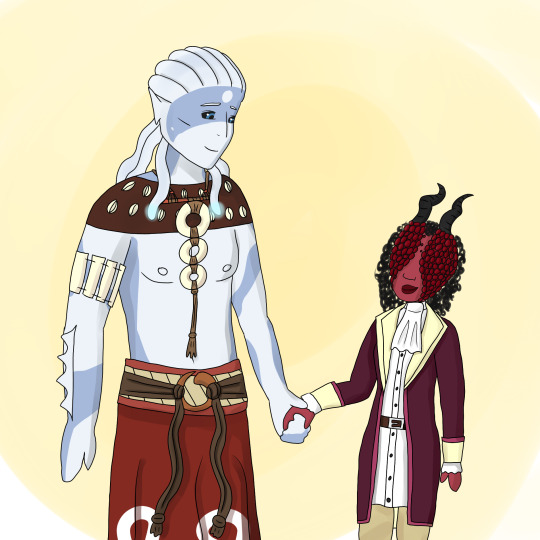
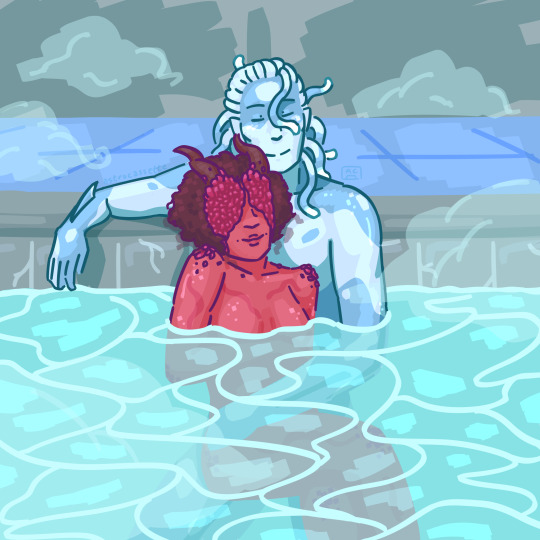
#thanks for the ask!#outeremissary#pillars of eternity#pillars of eternity 2#watcher amali#tekehu#amalixtekehu#saya no uta#cw blood#cw gore#cannibalism mention#cw body horror
9 notes
·
View notes
Text
Naples vs Positano - (2023) Comparison Guide
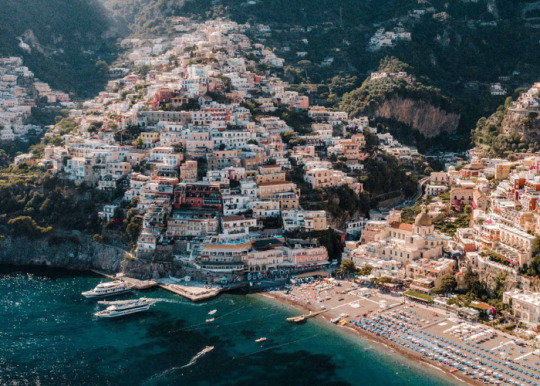
Are you trying to decide between a trip to Naples and Positano for your next getaway? The decision can be tricky, as both cities offer unique experiences, and it can take time to know where to start. Our 2023 Naples vs Positano Comparison Guide is here to help as we take a closer look at the two cities, their attractions, and what each has to offer. From the stunning views of the Amalfi Coast to the incredible food, culture, and history of Naples, this guide will give you all the information you need to choose the perfect destination for your next holiday.
Table of ContentsNaples vs Positano - Quick Overview
Naples
Positano
Culture and History
Climate and Geography
Attractions and Entertainment
Cost of Living
Activities
Beaches
Things to Do in Naples: Top Attractions of Naples
1. Castel Nuovo
2. Piazza Plebiscito
3. Royal Palace
4. Museo Archeologico
5. Teatro di San Carlo
6. Museo Regionale della Meditereanee
7. Museo di Capodimonte
8. Palazzo Reale
9. Duomo di Napoli
10. Chiesa di Santa Maria del Carmine
11. Mercato Municipio
12. Museo Nazionale di Capodimonte
Things to Do in Positano
Visit the Miramare Castle
Visit the Church of Santa Maria del Carmelo
Visit the Forte dei Marmi
Explore the Forte Sant’Andrea
Food: Naples vs Positano
Naples vs Positano: Entertainment and Nightlife
Weather: Naples vs Positano
Transport: Naples vs Positano
Naples vs Positano: Which is the Better City?
Cost of living
Health care facilities
Natural beauty
Weather
Conclusion
Naples vs Positano - Quick Overview
- Naples is a large city in southern Italy, while Positano is a small town on the Amalfi Coast.
- Naples is known for its historical sites, such as the ancient Roman ruins of Pompeii and Herculaneum, as well as its vibrant culture and vibrant street life.
- Positano is known for its picturesque scenery and colorful buildings cascading down a hillside to the sea. Beaches, luxury accommodations, and stylish boutiques make it a popular tourist destination for various reasons.
- Naples is a bustling urban center with a population of over 1 million people, while Positano is a small, picturesque town with a population of around 3,000 people.
- Naples has a wider range of dining and nightlife options, and Positano is more peaceful and idyllic but has fewer activities and amenities.
- The cost of living in Naples is more affordable than that of Positano, a resort town that features luxury shopping and resorts.
- Naples is well connected by public transportation, and Positano is only accessible by road and can be difficult to reach during peak season.
Naples
Neapolis, a coastal city located on the Bay of Naples, is one of the most populated cities in southern Italy. There are more than a few reasons why Merano is considered one of the best cities in the world, such as its vibrant culture and history. An interesting history has been written about the city. Over the centuries, it has been occupied by many invaders and rulers, starting with the Greeks in the 8th century BC. Formerly the capital of the Kingdom of Naples, then the Kingdom of the Two Sicilies, it was an important bridge connecting the two islands. It was a major center of the arts and culture during the Renaissance.
In today's Naples, around one million people live in a bustling city. It is one of the busiest ports in Europe and is renowned for its vibrant fish market. Many historic sites, monuments, and churches are located in this city, which also boasts a rich cultural heritage. There are many delicious restaurants in the city, most notably pizza. It is said that Naples still has the best pizza in the world since it is the birthplace of the Margherita pizza! Pasta Alla Genovese and spaghetti alla puttanesca are two of the unique dishes to be found in Naples.
The climate in Naples is mild, and the city has plenty of sunshine throughout the year. It’s a great place to visit during the summer months, as the beaches are beautiful and the temperature is warm. Naples is a great place to explore, with so much to see and do. Among the attractions are museums, galleries, churches, and other places of interest. Naples is an ideal destination for romantic getaways and exploring the culture and history of Italy.
Positano
Positano is the perfect place for a luxury escape, a picturesque town perched high on a cliff overlooking the Tyrrhenian Sea. Its narrow, winding streets and stunning architecture make it easy to see why the town has been a favorite of the rich and famous for centuries. Today, Positano is a popular tourist destination, with luxury hotels, restaurants, and shops catering to visitors who want to enjoy the area's exclusive lifestyle. Beautiful scenery and a scenic location make this town the perfect place to relax and enjoy the Mediterranean atmosphere.
Culture and History
As one of the most important cities in Italy, Naples has a long and rich history dating back to the Roman Empire. The city's many museums, churches, and monuments showcase its vibrant culture. Naples's must-see cultural sites include the Pompeii archaeological site, the Royal Palace of Naples, and the Cathedral of Naples.
However, Positano, located along the Amalfi Coast, is a small settlement. A hillside of colorful houses cascades down a hillside to the sea, giving it a picturesque setting. Positano has a more laid-back atmosphere compared to Naples and is known for its art, fashion, and music scene. The town has a small but charming historic center with many shops and restaurants.
Climate and Geography
Naples, located on the southern coast of Italy, is typically hot and humid in the summer, with milder temperatures and less humidity in the winter. Positano, on the other hand, is located on the north coast of Italy and has a much more temperate climate with colder temperatures in the winter and hotter temperatures in the summer. Naples also has a much higher population density, which can make it more crowded and noisy. Conversely, Positano has a much lower population density, which can make it more peaceful and relaxing.
In addition to their different climates, Naples or Positano also have different cultural backgrounds. Naples is heavily influenced by Roman culture, while Positano is more closely aligned with Greek culture. This cultural difference can be seen in the two cities' architecture, food, and lifestyle.
Attractions and Entertainment
When it comes to attractions and entertainment, Naples and Positano have a lot in common. Both cities offer a wealth of historical sites, stunning coastlines, and nightlife galore. Nevertheless, when deciding which town is a better fit for you, there are a number of key differences to consider.
For one, Naples is a much more bustling city. It has more traditional attractions, such as the Royal Palace and the Catacombs of Naples, and more contemporary attractions, such as the Planetarium and the Museum of Fine Arts. Conversely, Positano, on the other hand, offers a more tranquil and scenic environment. It is perfect for those who want to take in the sights and sounds of the local community. Both cities are home to top-notch restaurants, and it is easy to find something to suit everyone's taste. Naples is also home to some of the best nightlife in Italy, while Positano is known for its secluded coves and crystal-clear water. Both towns have something unique to offer, so it is up to the tourist to decide which one is right for them.
Cost of Living
There are a few things to consider when comparing Positano vs Naples in terms of the cost of living. In Naples, rental prices are higher, and the cost of groceries is higher. However, the cost of utilities is lower in Naples. In Positano, rental prices are lower, and the cost of groceries is higher. However, the cost of utilities is lower in Positano. Additionally, the cost of living in Positano is more expensive than Naples for clothing and entertainment.
Each city's characteristics should be considered when determining the cost of living. Overall, Naples is more expensive, but there are some areas where Positano is more affordable. You can find a better deal in Positano if you are looking for an affordable option.
Activities
Naples has a lot to offer in terms of activities, from visiting historical sites to shopping and nightlife. Some of the most important ancient Roman and Greek artifacts can be found in the National Archaeological Museum of the city, which is home to numerous museums and galleries. The city has a vibrant nightlife scene, bars, clubs, and music venues.
Beaches
Swimming, sunbathing, and water sports are popular in Positano, which has beautiful beaches. Visitors can also take a boat tour of the Amalfi Coast, which offers stunning coastline views and nearby islands. The town is also home to art and fashion boutiques, spas, and wellness centers.
There are two very popular beaches in southern Italy: Naples and Positano. They both have their unique charm and are worth a visit if you're in the area. So, which one should you choose? Naples is a bustling city with a lot to see and do. The beach is just one part of what makes this city great. If you're looking for a beach vacation with lots of activities and nightlife, then Naples is the place for you.
A relaxed atmosphere prevails in Positano, however. There is no better beach in the world than this one. It is breathtaking. Positano's Mediterranean sun and relaxing atmosphere make it a perfect place to enjoy a few days of relaxation.
Would you like to go to a particular beach? The type of vacation you want depends on your needs. Naples is the place to be if you want to experience a lively city with a great beach. It's the perfect beach vacation destination if you want a more relaxed vacation.
Things to Do in Naples: Top Attractions of Naples
You can’t ignore that Naples is Italy's second biggest city. It is also the capital of Campania and is situated on the southern tip of Italy. People who have visited Naples usually want to visit this city's famous places and have a great time.
Here are the top things to do in Naples that you must try before returning to your hometown.
1. Castel Nuovo
Castel Nuovo is the oldest castle in Naples. It was built by the French architect Filippo Gagliano in 1486 and has become one of the top attractions of Naples.
2. Piazza Plebiscito
It is the largest public square in Naples, and you can enjoy a relaxing walk in the beautiful square.
3. Royal Palace
It is the official residence of the Queen of Italy. The Royal Palace is a large palace that was built in the 1600s.
4. Museo Archeologico
This museum is located in the city's heart and is a major attraction. It has a collection of Greek and Roman antiquities.
5. Teatro di San Carlo
This is one of the most famous theatres in Europe, and it is one of the top attractions of Naples.
6. Museo Regionale della Meditereanee
This museum is one of the city's most important symbols and the country's second most important art museum.
7. Museo di Capodimonte
It is a royal museum that is dedicated to the kings of Naples.
8. Palazzo Reale
This large palace was built in the 17th century and symbolized the city.
9. Duomo di Napoli
The cathedral is the largest church in the city, and it is the cathedral of the city.
10. Chiesa di Santa Maria del Carmine
This church is the oldest one in Naples, and it is also one of the top attractions of Naples.
11. Mercato Municipio
As one of the most popular things to do in Naples, it is a food market that is located near the Duomo di Napoli.
12. Museo Nazionale di Capodimonte
A collection of paintings can be seen in this museum that occupies a former palace that is now a museum.
Things to Do in Positano
Positano is one of the most beautiful towns in Italy. This is the home of beautiful beaches and magnificent cliffs. It has been named the most romantic city in the world. Positano attracts thousands of tourists yearly, so it is no surprise that it attracts many people.
Here are the best things to do in Positano:
Visit the Miramare Castle
The southern town is known for its castle, the city's main attraction. It was built in 1560, and it has an old fortification. From the castle, you can enjoy some amazing sea views. The castle is divided into several parts, including the main gate and the chapel.
Visit the Church of Santa Maria del Carmelo
A church of this kind can be found in the northern part of Positano, the oldest church in the town. The church was built on a rock and was first built in the Middle Ages.
Visit the Forte dei Marmi
It is one of the biggest castles in the town, and it is also known as “the Fortress of Miramare.” It is a fortress surrounded by water and has beautiful sea views. The castle is divided into several parts: the main gate, the prison, the drawbridge, the chapel, and the towers.
Explore the Forte Sant’Andrea
An eastern part of the town contains this fortress. This is the smallest castle in Positano, built in the 16th century. With a small park surrounding it, it offers beautiful sea views.
Food: Naples vs Positano
Naples and Positano are two different cities in Italy, each with unique culinary traditions. Naples, located in southern Italy, is known for its Neapolitan pizza, which is made with a soft, doughy crust and various toppings. Other traditional dishes from Naples include spaghetti alle vongole (spaghetti with clams), frittata di spaghetti (spaghetti omelet), and sfogliatelle (a type of pastry filled with sweet ricotta).
A popular dish in Positano is spaghetti alle vongole (spaghetti with clams). Another popular dish is Pesce Alla Positano (Positano-style fish). Positano is also known for its lemon groves, and many dishes in Positano feature fresh lemons as an ingredient. Naples is known for its pizza, and Positano is known for its seafood dishes with lemon as an ingredient.
Naples vs Positano: Entertainment and Nightlife
When it comes to nightlife, Naples is the queen. The city has a wealth of bars, clubs, and pubs, and there's always something happening. But if you're looking for an adventure and want to enjoy some of the best views in Italy, then Positano is the perfect place to be.
The stunningly beautiful town has miles of coastline and plenty of bars and restaurants overlooking the ocean. If you're looking for a night out that will leave you feeling exhilarated and invigorated, you can't go wrong with a night in Naples or Positano.
Weather: Naples vs Positano
When it comes to weather, Naples and Positano are two very different cities. Naples is known for its hot summers and generally mild winters, while Positano experiences more moderate weather, with summer temperatures reaching the upper 30s and winter temperatures in the teens. However, despite their different weather patterns, both cities have something to offer visitors regarding climate.
SIRENIA and SAVONA BEACH are some of Naples' top beaches, while Positano has miles of sandy beaches that stretch for miles. In addition to the amazing beaches, Naples also features a variety of attractions, including the Palace of Caserta and the National Museum of Naples.
If you're looking for a city with a more temperate climate, Positano is the perfect place for you. The town of Positano is not only known for its beautiful beaches but it is also known for its great restaurants and shops, making it a great place to spend a day or two. Finally, both cities offer a wealth of history and culture, so there's something for everyone to enjoy.
Transport: Naples vs Positano
When it comes to transportation, Naples and Positano have a few things in common. They're both located on the Amalfi Coast, which means they have access to some of the best beaches in the world. They're both popular tourist destinations, so plenty of transportation options are available.
You have come to the right place if you want to go on a scenic drive in Naples. The city is surrounded by water, and many beautiful beaches and villas can be seen. Among tourist destinations, Positano is more popular. You can spend a day shopping or eating here, and there are a lot of restaurants there as well.
When it comes to more convenient transport options, Naples is the place to be. Many buses and trains travel through the city, and it's easy to find a route that suits your needs. Conversely, Positano is less populated, so you might have to wait longer for a bus or train.
A scenic drive in Naples will be a better choice if you are looking for a scenic drive. A bus or train to get you where you need to go is difficult to find in Positano if you want to be in a more populated area.
Naples vs Positano: Which is the Better City?
If you are living in Italy, you must have heard about the two most popular cities in the country, Naples, and Positano. If you have visited either of the cities, you will agree that each has its charm. So, to know which city is the best to live in, you need to compare the two. Here are some reasons why you should choose either of the cities.
Cost of living
Positano is cheaper than Naples, and both cities are popular among tourists. If you are a tourist, you will be happy to know that you can visit any of the cities quickly.
Health care facilities
Both cities are famous for their healthcare facilities, so it will be easy to treat if you have any medical issues.
Natural beauty
Both cities are located on the Amalfi coast and have a beautiful view of the surrounding mountains. A rich history, culture, and arts also surround both cities.
Weather
Positano has mild weather and a Mediterranean climate. On the other hand, the weather in Naples is hot and humid. So, if you like to spend your time outside, you can enjoy the weather in both cities.
Conclusion
Naples and Positano are both unique and beautiful destinations in Italy with a lot to offer. Neapolitan pizza and a vibrant nightlife are among the highlights of Naples' rich history and culture. Positano is a charming town on the Amalfi Coast, known for its picturesque setting, seafood, and art scene. If you're looking for a more laid-back and relaxing vacation, Positano might be the better choice. However, if you're looking for a cultural experience that's more exciting, Naples is the best choice.
Read the full article
2 notes
·
View notes
Note
Happy Storyteller Saturday!!!!!!! The Traitor’s Heir seems very intriguing!!! Could you gush about the setting a little bit? "Italian inspired fantasy world" absolutely slaps as a description!! How do you use that influence/aesthetic to shape your story and characters?
Happy STS! Thanks for the ask!
The Italian inspiration for the setting came about when I thought that for all the fantasy worlds that take inspiration from Europe, not many use Italy- home of both Ancient Rome and the Renaissance. So I decided to be the change I wanted to see in the world.
The major influence on the setting is transportation- Italy has a lot of bodies of water, so characters usually take a boat to get places as opposed to a carriage- which means journeys can take longer, and you run the risk of storms/shipwrecks.
The geographical features also affect what fantasy creatures show up—for example, there’s so much water that sirens make more sense than fairies, for instance.
Also, the existence of Sicily makes it really easy to have an island where characters can travel to/send prisoners- which becomes extremely plot relevant.
The time period I took the bulk of my inspiration from was the 1400s and 1500s- so the heyday of the Renaissance. I split the country into two for a reason- one half is based on the Dark Ages, the other half is starting to remake itself after a couple decades of tragedy.
When I was building the lore for the world, I decided to start the calendar from when the region was unified- which I based on the legend of Romulus and Remus. Also, the government is an absolute monarchy, but the current monarch chooses their heir instead of it being their child or relative- which is based on the system Augustus set up for the Roman Empire. (I also just think it’s a really cool system that is a lot of fun to play with in fiction.)
8 notes
·
View notes
Text
Participated in two different gaming sessions today, which inter alia reduced my un-played games pile by 3, in the course of playing six total games.
Shake That City (2023/currently on Kickstarter, but I already have a copy because I lucked into one). Is a very accessible city-building with a really nifty randomizing gimmick (which spits out a 3x3 spaced grid of cubes of different colors) that plays in about 15 minutes. Highly recommended as a filler/family game. (Played twice as an opener, because fast.)
Tekhenu: Obelisk of the Sun (2020) is a fairly heavy dice-drafting game conceptually, but played shockingly fast for its depth. (We finished a 3-player game in under 90 minutes once everyone knew the rules.) The eponymous obelisk is the center of a six-sector wheel of areas to draft dice from. At any given time, two sectors are in daylight, two are in shade, and two are in darkness (the obelisk rotates as you play to reflect the sun moving). The dice you are drafting to take actions or collect resources come in five different colors, and each color will either be pure, tainted, or forbidden depending on the light/shade/dark situation. Every four turns, you are check the scales on your player board, and you want the pure and tainted side of your scales to be as balanced as possible. This is on top of caring about both the color and pips of the dice for the actions you are taking with them. It makes for a very interesting puzzle. I enjoyed this the most of the three T-city games I have played (more than Tzol'kin or Teotihuacan; I haven't played Tawantinsuyu, Tabbanusi, or Tiletum).
Wild Space (2021) is a (mostly) card game of combo-making and set-collection featuring anthropomorphic animal astronauts. A little more complicated than the above, but still in the filler/family category. Takes about 20 minutes to play. (Played twice as a closer, because fast.
The above was all group one, which I hosted during the day. Then I went out for the evening and continued with a different group...
Virtu (2022) is an area-control game set in Renaissance Italy, where you take actions using a personal,modifiable rondel. The rulebook is not great, and the cadence of the game takes some getting used to, but once we got into the swing of things it was very interesting.
2 notes
·
View notes
Text
Worldbuilding | North African Livelihood, 1920

A Camel Plow Being Used In Algiers, Algeria, North Africa, In The Early 20th Century.
As a result of being situated so close to Europe, North Africa was majorly under Spanish or French rule during the early 20th century. The Moroccan protectorate itself was established in 1912, after the Entente Cordiale—a treaty concluded between France and Britain in 1904, which settled a number of hostilities between the two countries—and the Cameroons had been ceded to Germany in 1911. Both acts together left France free to divide the country with Spain, which took over the Rif Mountains in the north and the border region with the Spanish Sahara in the south. Libya was similarly invaded by Italy in 1911, but the prolonged resistance of the Sanūsiyyah in Cyrenaica denied the Italian Fascists control of the country until 1931.
During this time, art schools in Egypt focused on academic, Renaissance-based training; the Orientalist and post-Impressionist imagery of the French settlers overshadowed indigenous modernist ones by Moroccan, Algerian, and Tunisian artists. European schools and galleries featured romanticised imagery of the local landscape.
Following World War I, North Africa was swept by a tide of nationalist and anticolonial movements; artists and intellectuals struggled to define national culture in the face of their particular histories and colonial realities. Debate among Egyptian intellectuals and writers centered on building a secular nation-state based on European models with an emphasis on education, industrialisation, and the emancipation of women. The Egyptian national government supported art institutions and sent graduates of the school, both men and women, to study in Europe, making Egypt a regional nexus for artistic innovation and training. Art as a creative discourse among modern Egyptians found its purpose at first in the nation’s reformist aspirations; intellectuals and artists were seen as best qualified to define the new features of modern Egypt. Thus, the movement for independence in Egypt accelerated.
In contrast to Egyptian artists, who benefit from the support of a national government and local patronage, other North African artists were marginalized, receiving limited training or support. The French promoted North African self-taught artists’ work in France as the art of an underdeveloped nation. They were more interested in reviving traditional Moroccan crafts. Despite their proximity to Europe, North African artists did not adopt contemporary Western art and techniques. Early works by these artists followed academic styles, adaptations of illumination and miniature painting. Without access to modern art institutions, North African artists rejected the imposed Orientalist and Neoclassical modes; many moved to France, where they adopted the new trends in Abstract Expressionism and other contemporary styles, returning after independence to lead a new international art movement. In the post-independence period, calligraphy emerges within the realm of abstraction in this region, as well as in other Arab countries.
France’s harsh occupation in Algeria was a reflection of its conception of the country as an extension of itself; French replaced Arabic in all public schools, and indigenous history and culture were excluded from the curricula. Foreign occupation continued to fuel a growing secular movement for independence.
As a result of these influences, there were several languages spoken by the people of North Africa during this time. They were as follows;
Arabic
French
Hebrew
Farsi
Portuguese
Spanish
Swahili
Turkish
Twi
Additionally, there were a few more spoken by specific local communities;
Berber/Imazighen (with regional dialects)
Punic
African Romance
Lybic
Coptic
Nubian
Greek
With the exception of Imazighen languages and Nubian, the rest are considered extinct languages.
0 notes
Text
Why Choose Car Rental in Florence?
Exploring the heart of Italian Tuscany promises a journey of unparalleled relaxation and unforgettable experiences. Yet, navigating this enchanting region without the convenience of a rental car Florence can prove to be quite challenging.
While the Renaissance-style architecture stands out as a prominent allure drawing travelers to the epicenter of this ancient empire, it is merely the tip of the iceberg. Amidst the picturesque landscapes, hundreds of charming cafes, gourmet restaurants, and cultural spectacles await to be discovered, enriching your journey with unparalleled delights.
Opting to rent a car at Florence airport affords you the luxury of maximizing your time for leisurely strolls through the city streets. This not only enhances your travel experience but also proves to be a prudent choice for managing both time and budget efficiently.
What Car Options Await You in Florence?
Much like its counterpart, Venice, Florence boasts a diverse array of vehicles catering to varied preferences, without the hassle of parking woes. From spacious minivans ideal for accommodating large groups and luggage, to luxurious SUVs tailored for the discerning traveler, the options are aplenty:
Minivan: Practical, spacious, and budget-friendly.
SUV: Luxurious and capacious, tailored for the elite traveler.
Convertible: Perfect for basking in the glorious Tuscan sunshine.
Sedan: Ideal for comfortable long-distance journeys.
Economy Car: Optimal for budget-conscious travelers seeking affordable rentals.
With an extensive selection available for each category, finding your ideal model is just a click away. Secure your booking now and embark on your Tuscan adventure in style.
Affordable Car Rental Rates in Florence
A myriad of rental companies and enticing offers await your reservation, ensuring competitive pricing for your convenience. Whether you're planning a summer getaway or a winter retreat, strategic considerations can further enhance your savings:
Pre-book for 10-15 days to unlock exclusive discounts.
Opt for long-term rentals for better value.
Exercise caution with local rental agencies; international companies often offer more reliable services.
Scrutinize contract terms and documents before finalizing your booking.
Avoid unnecessary add-ons to streamline costs without compromising on quality.
Rest assured, even amidst the bustling tourist season, securing a rental car remains a hassle-free endeavor.
Additional Car Rental Options in Florence
Maximize your travel experience with a host of supplementary options designed to elevate your journey. Online bookings come replete with complimentary features such as card or cash payment, deposit-free reservations, flexible durations, and hassle-free cancellations. While premium add-ons, including security, multimedia, navigation packages, insurance coverage, child seats, extra drivers, and WiFi access, enhance convenience without significantly impacting your budget.
With a plethora of options at your disposal, tailor your rental experience to suit your unique preferences seamlessly.
Reputable Rental Companies in Florence
Nestled within the heart of Italian Tuscany, Florence plays host to a multitude of renowned rental agencies including Budget, Alamo, Sixt Italy, Noleggiare, Maggiore, Avis, Locauto, among others. While local rental companies and private owners present enticing alternatives, exercise caution to mitigate potential risks, as negative experiences may arise.
For peace of mind, opt for internationally acclaimed agencies boasting a stellar track record within the local market. Secure your booking now to access the latest offers from trusted providers.
Navigating Florence: Reviews and Recommendations
Driving through central Tuscany promises to be a highlight of your European escapade. While Florence car rentals offer unparalleled opportunities for exploration, it's imperative to consider both positive and negative feedback to make an informed decision.
Pros:
Convenient access to car rentals at Florence airport.
Extensive selection of available offers.
Seamless online booking process.
High reputation of international companies.
Competitive rates for short-term rentals.
Cons:
Peak season surges in pricing.
Some agencies mandate International Driving Permits.
Limited availability of premium segment offerings.
Essential Documents for Car Hire in Florence
To secure your rental car in Florence, ensure you possess a valid Passport for identification purposes, alongside a Driver's License granting you the right to operate a vehicle. While these requirements are standard across most Italian rental agencies, it's advisable to verify specific prerequisites during the booking process. Additionally, an International Driver's Permit can offer added reassurance, facilitating hassle-free transactions.
Embark on your Tuscan odyssey today, and bid farewell to the quest for discount coupons. Here's to wishing you a splendid journey through the sun-kissed landscapes of Tuscany!
#Car Rental Florence#Rental Car Florence#Rent a car Florence#cheap car rental Florence#rent a car Florence cheap#rent a car Florence long term#rent a car Florence cheap price#rent a car Florence per day#rent a car in Florence for one day#how to rent a car in Florence#rent a car business in Florence#rent a car online Florence
1 note
·
View note